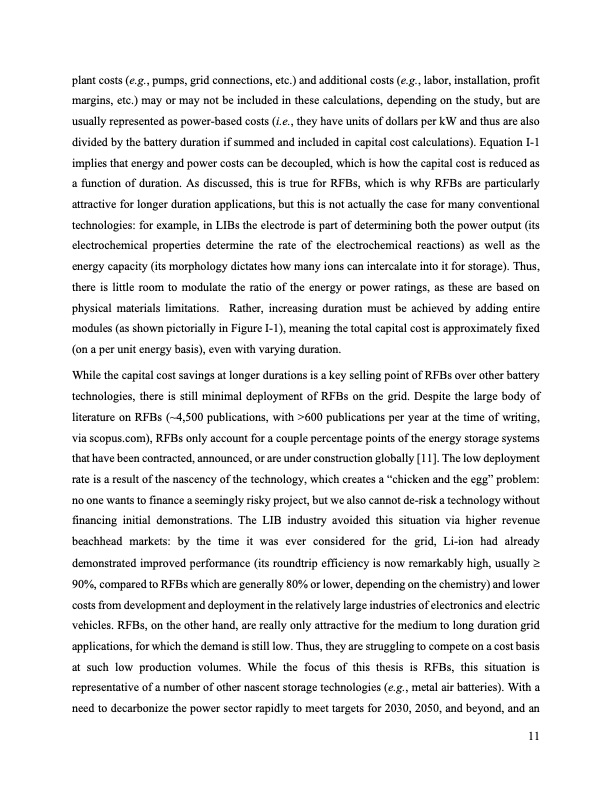
PDF Publication Title:
Text from PDF Page: 011
plant costs (e.g., pumps, grid connections, etc.) and additional costs (e.g., labor, installation, profit margins, etc.) may or may not be included in these calculations, depending on the study, but are usually represented as power-based costs (i.e., they have units of dollars per kW and thus are also divided by the battery duration if summed and included in capital cost calculations). Equation I-1 implies that energy and power costs can be decoupled, which is how the capital cost is reduced as a function of duration. As discussed, this is true for RFBs, which is why RFBs are particularly attractive for longer duration applications, but this is not actually the case for many conventional technologies: for example, in LIBs the electrode is part of determining both the power output (its electrochemical properties determine the rate of the electrochemical reactions) as well as the energy capacity (its morphology dictates how many ions can intercalate into it for storage). Thus, there is little room to modulate the ratio of the energy or power ratings, as these are based on physical materials limitations. Rather, increasing duration must be achieved by adding entire modules (as shown pictorially in Figure I-1), meaning the total capital cost is approximately fixed (on a per unit energy basis), even with varying duration. While the capital cost savings at longer durations is a key selling point of RFBs over other battery technologies, there is still minimal deployment of RFBs on the grid. Despite the large body of literature on RFBs (~4,500 publications, with >600 publications per year at the time of writing, via scopus.com), RFBs only account for a couple percentage points of the energy storage systems that have been contracted, announced, or are under construction globally [11]. The low deployment rate is a result of the nascency of the technology, which creates a “chicken and the egg” problem: no one wants to finance a seemingly risky project, but we also cannot de-risk a technology without financing initial demonstrations. The LIB industry avoided this situation via higher revenue beachhead markets: by the time it was ever considered for the grid, Li-ion had already demonstrated improved performance (its roundtrip efficiency is now remarkably high, usually 3 90%, compared to RFBs which are generally 80% or lower, depending on the chemistry) and lower costs from development and deployment in the relatively large industries of electronics and electric vehicles. RFBs, on the other hand, are really only attractive for the medium to long duration grid applications, for which the demand is still low. Thus, they are struggling to compete on a cost basis at such low production volumes. While the focus of this thesis is RFBs, this situation is representative of a number of other nascent storage technologies (e.g., metal air batteries). With a need to decarbonize the power sector rapidly to meet targets for 2030, 2050, and beyond, and an 11PDF Image | Bringing Redox Flow Batteries to the Grid

PDF Search Title:
Bringing Redox Flow Batteries to the GridOriginal File Name Searched:
Rodby-krodby-phd-chemE-2022-thesis.pdfDIY PDF Search: Google It | Yahoo | Bing
Salgenx Redox Flow Battery Technology: Salt water flow battery technology with low cost and great energy density that can be used for power storage and thermal storage. Let us de-risk your production using our license. Our aqueous flow battery is less cost than Tesla Megapack and available faster. Redox flow battery. No membrane needed like with Vanadium, or Bromine. Salgenx flow battery
| CONTACT TEL: 608-238-6001 Email: greg@salgenx.com | RSS | AMP |